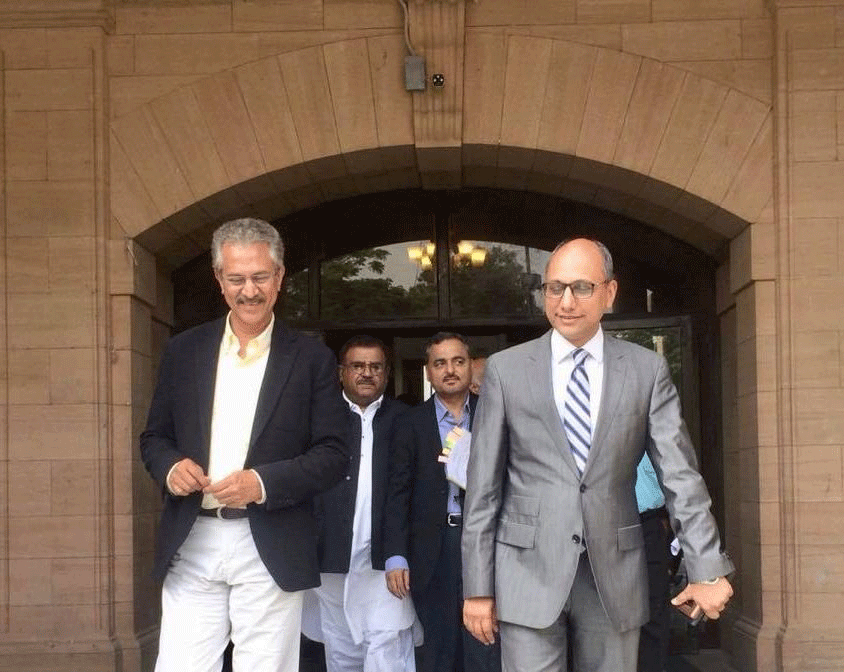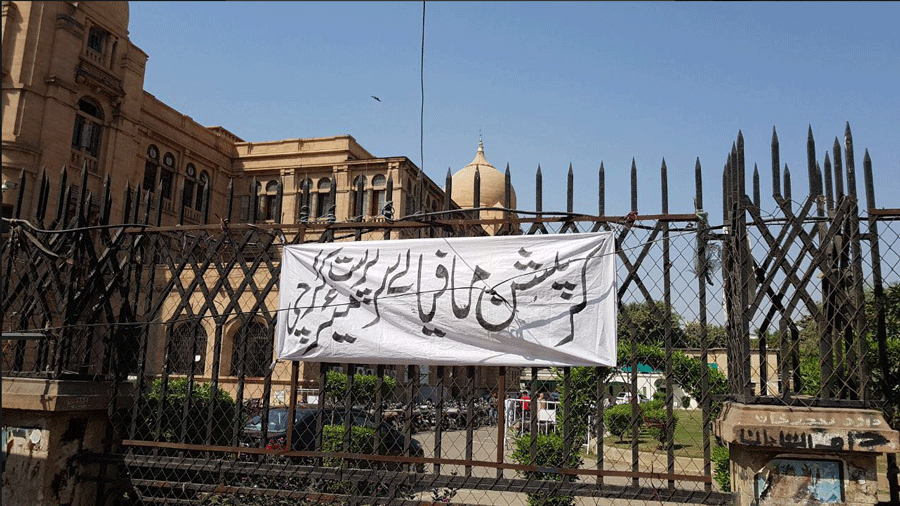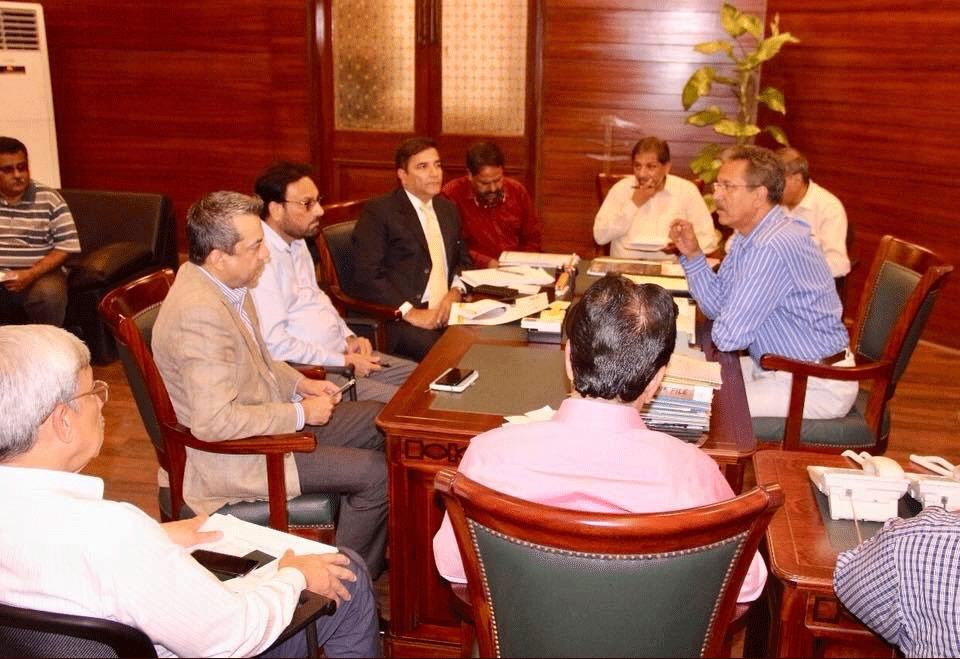The MQM’s Last Front
By Ali Arqam | Newsbeat National | Published 7 years ago

A few years back, Karachi made the headlines in Pakistan’s print and electronic media alongside images of dead bodies, burning tyres, torched mini-buses, deserted streets and the blood-splattered tomb of the country’s founding father. The city was referred to in those days as ‘Shehr-e-Quaid.’ The phrase could easily have been held as a reference to Quaid-e-Tehreek – a title used to denote the founder of Muttahida Qaumi Movement (MQM). But behind the smokescreen of violence there were closed-door negotiations between the two major contenders for power – the MQM and the Pakistan Peoples’ Party (PPP).
Violence played a major role in determining the outcome of the negotiations, both in the centre and in Sindh. The issues at the top of the agenda were the powers exercised by the Local Governments (LGs) and the control of civic bodies, namely the Karachi Metropolitan Corporation (KMC), the Karachi Development Authority (KDA), the Lyari Development Authority (LDA), the Malir Development Authority (MDA), the Karachi Water and Sewerage Board (KWSB) and the Karachi Building Control Authority (KBCA).
The coalition turned into an on-again off-again arrangement – a trend that continued till February 2013, when the MQM finally chose to sit on the opposition benches. In August 2013, the PPP enacted the Sindh Local Government Act 2013, a law that further restrained the powers of LGs. According to experts, it was a stultified version of the Local Government Act of 1979. The MQM approached the Supreme Court against the legislation on the grounds that it was a violation of Article 140A of the Constitution, which provided political, administrative, and fiscal autonomy to the LGs.
During the Rangers’ operation in Karachi, political players were no longer able to use violence as a means to achieve their aims. The MQM underwent a meltdown in the face of the raids conducted on the party’s offices and subsequent arrest of party workers by the law enforcement authorities (LEAs). While the party was unable to maintain its iron grip on the city, it nevertheless went on to win the LG election in 2015 by a thumping majority, proving that it still enjoyed support in the city. Out of the six district chairmen that were elected, four belonged to the MQM.
On August 22, 2016, a seditious speech by Altaf Hussain resulted in another crackdown on the party. With the exception of a few, the party’s leadership in Pakistan parted ways with the Quaid-e-Tehreek and formed the Muttahida Qaumi Movement-Pakistan (MQM-P). Initially, MQM-P managed to pull its weight effectively and within the same week, voted in Waseem Akhtar as mayor and Arshad Vohra as deputy mayor.
“There was a great deal of confusion in the lower ranks of the party,” says an elected MQM representative from Baldia town. “But in the meetings held before the election for mayor, it was reiterated that we will keep the organisation intact and serve our voters through the LGs,” he adds. “But things weren’t the same in the months that followed and the party’s organisational discipline was torn apart.” To cope with financial restraints, he says, the party had to mobilise its cadres to support the LGs in its endeavours. “The MQM-P’s 100-day cleanliness drive, for instance, had little impact as the party was unable to effectively mobilise its lower ranks.”

Commenting on a lack of checks-and-balances on the performance of LG representatives, a resident of Sector 5-G Saeedabad says, “In the past, a single fax to the London Secretariat, or a telephone call to Nine Zero would initiate action and address our grievances. Now that they are fighting each other, who will take notice of our complaints?” There was a sense among elected representatives that this may be their last stint in power; everyone was out to make a fortune.
Adding insult to injury, deputy mayor Arshad Vohra quit the MQM-P and joined its rival, the Pak Sarzameen Party (PSP). In a press conference, Vohra accused the MQM-P of deliberately underperforming at the LGs level in an attempt to win more powers for the KMC.
However, the MQM-P alone cannot be held responsible for the shortcomings of the LGs. The PPP, enjoying a third consecutive term in the Sindh government, promotes the concept of devolution of powers and fiscal autonomy but has not taken steps to empower the LGs.
Under the existing LG system in Sindh, the KMC has lost 30 per cent of the functions accorded to it by the 1979 Act. The portfolios of solid waste management, the building control authority and town planning are now in the realm of the provincial government and the minister for local governments. PPP representatives say that the bodies have been moved to the provincial level so that a degree of ‘uniformity’ can be achieved in policymaking. Yet the provincial government does not follow this principle when it comes to District Municipal Corporations (DMCs) in Karachi, which are essentially independent of the KMC. Karachi’s Mayor, Waseem Akhtar, demands that DMCs be abolished and the city be put under his control.
An expert reveals that the KMC, the DMCs and Union Councils (UCs) perform their functions as parallel bodies and lack an organisational hierarchy. “Confusion over powers and responsibilities has resulted in redundancy and the duplication of authority,” he says. “It has also created a serious problem when it comes to garbage disposal. There are several points spread across the city where the garbage is dumped on the borderlines [of jurisdictions] so that others are blamed for the lack of action.”
PPP officials justify provincial control of the KDA, LDA and MDA on the grounds that MQM representatives had indulged in illegal practices when these bodies were under the LG. However, the PPP too gave away thousands of acres of MDA land to Bahria Town and facilitated it in acquiring more land. There are reports that the K-4 water supply project will provide sustenance to DHA City and Bahria Town on the M-9 motorway at the expense of the rest of Karachi.
In response to KMC’s complaints of financial restraints, the provincial government cites the Octroi Zilla Tax (OZT), the the Urban Immovable Property Tax (UIPT), special funds for salaries and pensions, and the Grant in Aid (GIA) through single line transactions. The Rs 6.5 billion allocated to the city under the provincial Annual Development Programme (ADP) is spent solely by the Sindh government and cannot be accessed by the KMC – the mayor’s capacity being merely advisory when it comes to ADP spending. Akhtar complains that the development schemes proposed by KMC are not given consideration. The PPP directs ADP spending towards those parts of Karachi where it enjoys a support-base, namely District South and Malir.

MQM representatives complain that KMC has few avenues of revenue generation through taxation, with some of its revenue sources having been devolved to the DMCs. They claim that the revenue – a major share of which is contributed by Karachi – is collected by the Sindh government and spent on the rest of the province. The MQM believes in the myth that Karachi generates 70 per cent of the federal revenue, while in fact the metropolis only contributes 38 per cent. It is only because the offices of various tax collecting authorities happen to be located in Karachi that 68 per cent of the country’s tax is collected there.
The LG bodies are also used by those in charge as a means to provide voters with jobs. They are overstaffed as a result of this. Both the MQM and PPP have never shied away from stuffing their supporters into these bodies. In his last days as mayor, Mustafa Kamal recruited thousands of employees. Similarly, when Agha Siraj Durrani was the minister for local governments, the SBCA filled its departments with members of his constituency in taluka Garhi Yasin. The KMC and the DMCs spend a major chunk of their budgets on the salaries of staff members and have absolute control over hiring and firing employees.
In the aftermath of the 2018 general elections, however, both the MQM-P and the PPP are faced with a new rival in Karachi. The MQM-P’s numbers were reduced significantly at the hands of the Pakistan Tehreek-e-Insaf (PTI), which swept the city. But since the LG is the domain of the provincial government, the PTI-led federal government has little say in its affairs. Nevertheless, the party could be a serious contender for the top slot in the next LG elections due in 2019. And Prime Minister Imran Khan has shown his resolve by forming a task force headed by Sindh Governor, Imran Ismail. It has devised a masterplan for the metropolis. Ismail has hinted that the projects would be initiated under the supervision of the mayor of Karachi, which suggests that both the MQM and the PTI will share the credit for the work.
Yet it is difficult to say who will stand to benefit more from these projects in the upcoming LG elections. Greater generosity towards the MQM-P would bring the PTI at odds with its allies from the Grand Democratic Alliance (GDA) and could kill its prospects in the rest of Sindh.
The MQM’s performance in the LGs may well be its last shot at survival. The PSP suffered a humiliating defeat in its election debut. It is down, but not dead. The party has been busy strengthening its foundations at the grassroots level by following the old units and sectors model of the MQM. This may earn the party dividends in the LG elections. The PPP, meanwhile, has little to worry about as its position in the rest of the province remains unchallenged.
Ali Arqam main domain is Karachi: Its politics, security and law and order


